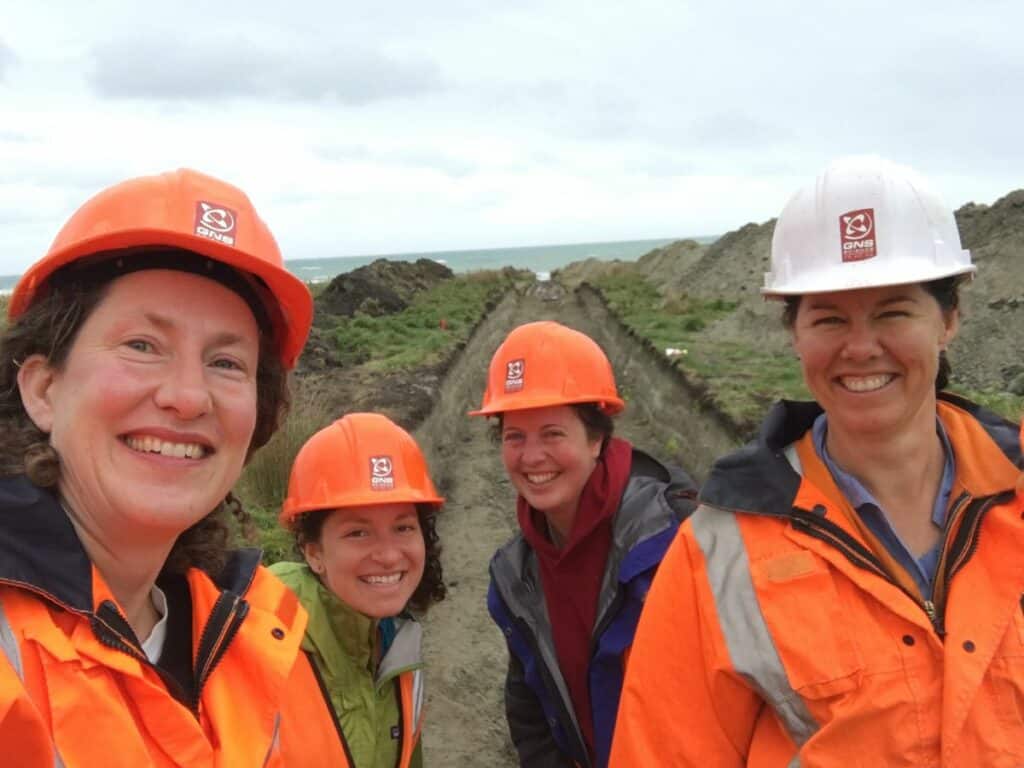Beneath the North Island of New Zealand there is a restless sleeper. Usually the sleeper is just breathing deeply but sometimes they twitch with a bad dream, or rearrange an arm or leg. Occasionally they heave and roll and dive deeply into a new position. Our sleeper is the Pacific Plate.
Our sleeper is covered by a rumpled patchwork blanket that is pushed up in some places and pulled down in others. In places it is folded over itself and the edges are being worn away or repaired with new material. This blanket is the Australian Plate.
This blanket is the beautiful land on which all North Islanders and some South Islanders live. We are at the mercy of the sleeper and their slumbering movements. We now know how to monitor and even anticipate the deep breathing, we can also measure twitching, and, although very unpleasant and challenging, we can manage ok with movement of a limb. However, full body movements will be bigger than anything we’ve witnessed in at least the last 200 years.
These large-scale movements (also known as subduction earthquakes) are those that occur between the sleeper and blanket – between the Pacific Plate and the Australian Plate. This boundary is the Hikurangi subduction zone – New Zealand’s largest fault. Subduction earthquakes are the largest earthquakes that happen worldwide and they cause the biggest tsunamis.
Most of the damaging earthquakes we’ve experienced in New Zealand have been on faults within the Australian Plate where there has been little or no movement between the two plates. However, we know our sleeper moves.
The 1947 Poverty Bay earthquakes caused an 11m high tsunami and were the result of a slight shift between the two plates. The 2016 Kaikōura earthquake was the result of numerous faults breaking in the Australian Plate but the sleeper contributed to the chaos by moving a little at the same time. So, what happens when the sleeper moves their whole body and how often does this occur?
Kate Clark, GNS Science earthquake geologist, with a group of colleagues, recently analysed all known past large earthquakes and tsunamis along the Hikurangi subduction zone. The purpose of this research was to systematically assess the evidence for these subduction zone earthquakes. Previous research has focused on individual patches of the blanket while this research looks at the overall pattern.
As witnessed in the 2016 Kaikōura earthquake, large quakes can raise land out of the sea. They can also drop land below sea level. The east coast of the North Island and northern South Island has many sites with stepped terraces (land raised in earthquakes) and drowned coastal plains (land lowered in earthquakes). Scientists identify past subduction earthquakes by looking for evidence of vertical coastal movements and tsunami inundation that occurred at the same time, at many sites along the subduction zone.
Over several decades many of these sites have been surveyed and dated by different geologists to find out how big the earthquakes were and when they occurred. This work started in the days when surveying was done with equipment called a dumpy level, notes were taken with a pencil and paper, and for radiocarbon dating you needed to find a large piece of shell or wood in the right place. These days GPS surveying, satellite imagery and photogrammetry are often used to document and measure the landscape features while radiocarbon dating can be done on much smaller pieces of shell and wood.
Kate’s work, recently published in Marine Geology starts to make a cohesive pattern out of a complicated patchwork of information. Studies from 22 sites along the Hikurangi subduction zone from Kaikōura in the south to East Cape in the north, and from the 1990s through to the present day, have all been used to better understand earthquake activity.
Looking at the big picture – the whole length of the blanket rather than individual squares of patchwork – we can see when our sleeper moved significantly over the last few thousand years. The Hikurangi subduction zone ruptured in large earthquakes at least 10 times over the last 7500 years. The most recent subduction earthquake was 500 years ago and the biggest (about 840 years ago) was a whole-body movement with evidence preserved from Marlborough to north of Gisborne. There is no obvious pattern between different parts – although the southern and central parts seem to move more than the northern parts.
Although these earthquakes ranged in size, all of them are likely to have been of greater magnitude than the M7.8 Kaikōura earthquake. We can’t estimate exact magnitudes from the existing dataset because there are not enough datapoints for each event (not enough patches of the blanket have been investigated). Also, because of gaps in time when there is no information, the dataset is too sparse to provide accurate estimates of how frequently these large earthquakes occur.
The number of past subduction earthquakes isn’t too different from what we suspected before this study but that was relying heavily on information from one site. Now that information from the whole coast has been integrated, we can be certain that large subduction earthquakes occur here and that very large ones are possible. It is definitely worth preparing for the next event.
The achievement of this research is really one of seamlessly stitching together lots of data. This has been made possible by ensuring over 700 radiocarbon dates have been calculated using the same techniques and by updating age estimates for 56 different records of earthquakes.
More pieces of the patchwork are currently being investigated as part of several large research programmes to better understand the Hikurangi subduction zone and the hazard it poses. Researchers hope to learn more about past subduction earthquakes by investigating records of intense shaking under the sea off the North Island’s east coast.
So, just like any sleeping body, the deep breathing is regular and frequent through the night, the twitching and limb movements are less regular and less frequent, and the whole body shifts only occasionally. For now, we can be thankful our sleeper is peaceful, but we know they will move again and disrupt the blanket that we call home. We have some unknown time before the next upheaval so let’s use that time to make ourselves more prepared for such movements.

